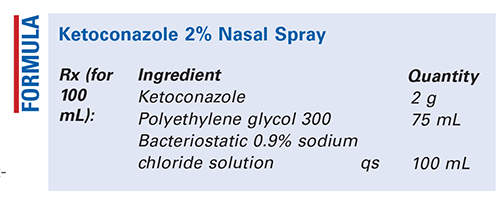US Pharm. 2021;46(7):58-59.

Method of Preparation: Calculate the required quantity of each ingredient for the total amount to be prepared. Accurately weigh or measure each ingredient. Add the ketoconazole and the polyethylene glycol (PEG) 300 to a beaker; heat to 80°C for 30 minutes and spin until dissolved. Allow the mixture to cool with continued stirring. Slowly add bacteriostatic 0.9% sodium chloride solution to final volume with continued stirring. Dispense in metered nasal spray pump and label.
Use: This preparation has been used for susceptible infections in the nasal cavity.
Packaging: Package in tight, light-resistant containers.
Labeling: Keep out of reach of children. Shake well. For the nose. Discard after ____ [time period].
Stability: A beyond-use date of up to 30 days may be used for this preparation.1
Quality Control: Quality-control assessment can include weight/volume, pH, specific gravity, active drug assay, color, rheologic properties/pourability, physical observation, physical stability (discoloration, foreign materials, gas formation, mold growth), and preservative-effectiveness test.2,3
Discussion: Fungal infections are becoming a more prominent health problem owing to widespread travel to and from endemic areas, AIDS, transplantation-related immunosuppression, chemotherapy, and frequent use of long-term broad-spectrum antibiotic therapy. Fungal infection should be suspected in patients with sinusitis who also have diabetes, leukemia, AIDS, or other conditions involving an impaired immune system.4
Fungi exist almost everywhere and are commonly found in the air, dust, soil, plants, and decaying organic matter. Fungi adhere to dust particles, which can be inhaled and then deposited on the nasal and paranasal sinus mucosa. This environment, being warm and moist, is an ideal situation for the proliferation of these organisms. Most people will never develop a fungal infection because they have resistance to the fungi. In compromised persons, however, fungal infections are becoming more commonplace.
There are four primary categories of fungal sinusitis: 1) acute/fulminant (most likely to affect persons with diabetes and compromised immune systems); 2) chronic/indolent (generally found outside the United States, mostly in Sudan and northern India); 3) fungus ball (mostly noninvasive and usually occurring in one sinus, most often the maxillary sinus); and 4) allergic (typically caused by allergy to Aspergillus).5
Sinusitis cases involving fungal infections are quite difficult to treat. Fungal infections can be extremely serious, and both chronic and acute fungal sinusitis require immediate treatment. In recent years, pharmacists have been asked to provide antifungal drugs in nasal delivery systems. Given the poor aqueous solubility of the antifungals, this is a challenging situation.
Treatment for fungal sinusitis may include oxygen; surgery; systemic antifungals; saline and antifungal irrigations, drops, and sprays; and corticosteroids. Antifungals used to treat fungal sinusitis include amphotericin, ketoconazole, miconazole, and nystatin.
Ketoconazole (Nizoral, C26H28Cl2N4O4, MW 531.43) occurs as odorless, white or almost white crystals. It is insoluble in water and sparingly soluble in alcohol. Ketoconazole is packaged in well-closed containers. In addition to being employed as an antifungal, this agent is used to treat susceptible fungal infections, including candidiasis, oral thrush, blastomycosis, histoplasmosis, paracoccidioidomycosis, coccidioidomycosis, chromomycosis, candiduria, chronic mucocutaneous candidiasis, and certain recalcitrant cutaneous dermatophyses. It is also used topically for the treatment of tinea corporis, tinea cruris, tinea versicolor, cutaneous candidiasis, and seborrheic dermatitis.1,6
PEG (Carbowax, polyoxyethylene glycol) is an addition polymer of ethylene oxide and water. PEG 300 is a clear, colorless or slightly yellow-colored, viscous liquid with a slight but characteristic odor and a bitter, slightly burning taste. It has a density of 1.11 g/mL to 1.14 g/mL. PEG is soluble in water and miscible in all ratios with other PEGs, and it is soluble in acetone, alcohols, glycerin, and glycols.7
REFERENCES
1. U.S. Pharmacopeia/National Formulary [current revision]. Rockville, MD: U.S. Pharmacopeial Convention, Inc; June 2021.
2. Allen LV Jr. Summary of quality-control testing for sterile and nonsterile compounded preparations, part 1: physical and chemical testing. IJPC. 2019;23(3):211-216.
3. Allen LV Jr. Summary of quality-control testing for sterile and nonsterile compounded preparations, part 2: microbiological testing. IJPC. 2019;23(4):299-303.
4. CDC. Fungal infections—protect your health. www.cdc.gov/fungal/features/fungal-infections.html. Accessed June 6, 2021.
5. Uri N, Cohen-Kerem R, Elmalah I, et al. Classification of fungal sinusitis in immunocompetent patients. Otolaryngol Head Neck Surg. 2003;129(4):372-378.
6. RxList. Ketoconazole. www.rxlist.com/consumer_ketoconazole_nizoral/drugs-condition.htm. Accessed June 2, 2021.
7. Weber KS. Polyethylene glycol. In: Sheskey PJ, Hancock BC, Moss GP, Goldfarb DJ, eds. Handbook of Pharmaceutical Excipients. 9th ed. London, England: Pharmaceutical Press; 2020:769-775.
The content contained in this article is for informational purposes only. The content is not intended to be a substitute for professional advice. Reliance on any information provided in this article is solely at your own risk.
To comment on this article, contact rdavidson@uspharmacist.com.





